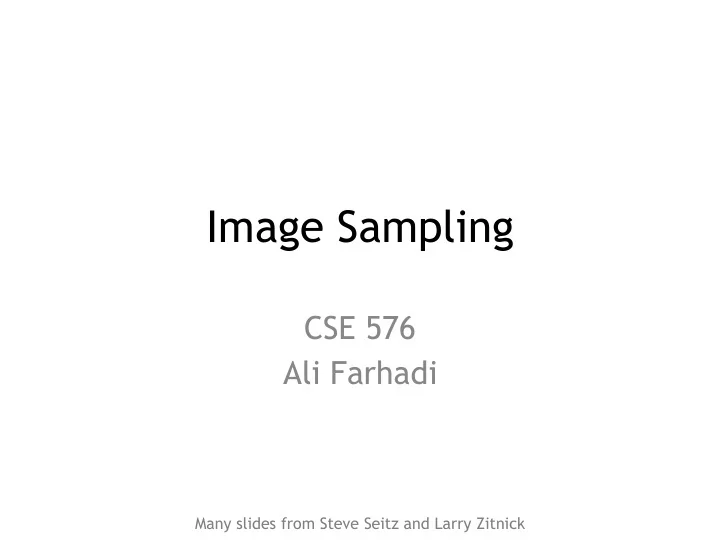

Image Sampling CSE 576 Ali Farhadi Many slides from Steve Seitz and Larry Zitnick
Image Sampling F( ) = F( ) =
Image Scaling This image is too big to fit on the screen. How can we reduce it? How to generate a half- sized version?
Image sub-sampling 1/8 1/4 Throw away every other row and column to create a 1/2 size image - called image sub-sampling
Image sub-sampling 1/2 1/4 (2x zoom) 1/8 (4x zoom) Why does this look so crufty?
Down-sampling • Aliasing can arise when you sample a continuous signal or image – occurs when your sampling rate is not high enough to capture the amount of detail in your image – Can give you the wrong signal/image—an alias – formally, the image contains structure at different scales • called “frequencies” in the Fourier domain – the sampling rate must be high enough to capture the highest frequency in the image
Sampling and the Nyquist rate Aliasing can arise when you sample a continuous signal or image • – occurs when your sampling rate is not high enough to capture the amount of detail in your image – Can give you the wrong signal/image—an alias – formally, the image contains structure at different scales • called “ frequencies ” in the Fourier domain – the sampling rate must be high enough to capture the highest frequency in the image To avoid aliasing: • – sampling rate ≥ 2 * max frequency in the image • said another way: ≥ two samples per cycle – This minimum sampling rate is called the Nyquist rate
2D example Good sampling Bad sampling
Subsampling with Gaussian pre-filtering G 1/8 G 1/4 Gaussian 1/2 Solution: filter the image, then subsample • Filter size should double for each ½ size reduction. Why?
Subsampling with Gaussian pre-filtering Gaussian 1/2 G 1/4 G 1/8 Solution: filter the image, then subsample • Filter size should double for each ½ size reduction. Why? • How can we speed this up?
Compare with... 1/2 1/4 (2x zoom) 1/8 (4x zoom)
Moire patterns in real-world images. Here are comparison images by Dave Etchells of Imaging Resource using the Canon D60 (with an antialias filter) and the Sigma SD-9 (which has no antialias filter). The bands below the fur in the image at right are the kinds of artifacts that appear in images when no antialias filter is used. Sigma chose to eliminate the filter to get more sharpness, but the resulting apparent detail may or may not reflect features in the image.
More examples Check out Moire patterns on the web.
Up-sampling How do we compute the values of pixels at fractional positions?
Up-sampling How do we compute the values of pixels at fractional positions? Bilinear sampling: f (x,y) f (x+1,y) f (x+0.8,y+0.3) f (x + a, y + b) = (1 - a)(1 - b) f (x, y) + a(1 - b) f (x + 1, y) + (1 - a)b f (x,y + 1) + f (x,y+1) f (x+1,y+1) ab f (x + 1, y + 1) Bicubic sampling fits a higher order function using a larger area of support.
Up-sampling Methods
Up-sampling Nearest Bilinear Bicubic neighbor
Up-sampling Nearest Bilinear Bicubic neighbor
Recommend
More recommend